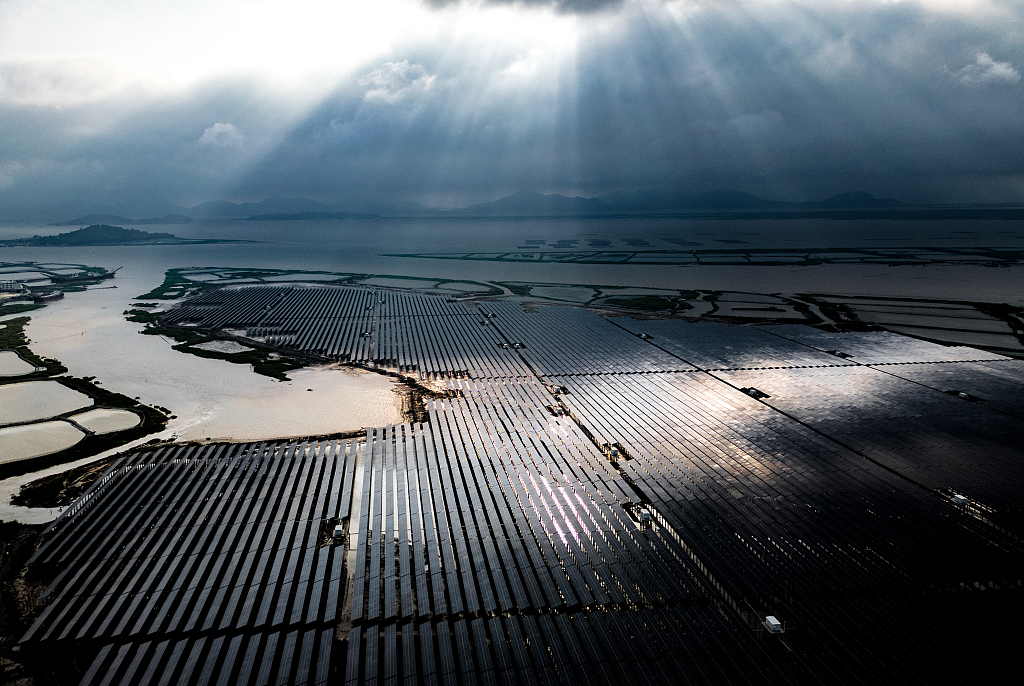
An aerial image of volunteers and goverment staffs salvaging floating objects on the river in Huzhou City, Zhejiang Province, China, June 5, 2023. /Xinhua
An aerial image of volunteers and goverment staffs salvaging floating objects on the river in Huzhou City, Zhejiang Province, China, June 5, 2023. /Xinhua
Editor's note: Havard Halland is a senior economist at the OECD Development Center. Justin Yifu Lin, a former World Bank chief economist, is Dean of the Institute of New Structural Economics and Dean of the Institute of South-South Cooperation and Development at Peking University. Alan Gelb is a senior fellow at the Center for Global Development.
Although French President Emmanuel Macron's recent summit for a New Global Financing Pact produced a "roadmap" toward reforming the global financial system, the proposed reforms are unlikely to mobilize private capital at the scale required to mitigate climate change. A key reason for this is that the roadmap largely fails to address the barriers that prevent pension funds and other large institutional investors from joining forces with multilateral development banks (MDBs). While proposed provisions to increase foreign-currency guarantees and pool currency risks are helpful, they are unlikely to be sufficient.
A critical problem with global climate finance today is that only a small share of it goes to developing countries. The International Energy Agency estimates that, to achieve net-zero emissions by 2050, capital spending on clean energy in these economies must increase from less than $150 billion in 2020 to over $1 trillion annually by 2030. Other estimates are even higher.
About 70 percent of this clean-energy investment will need to come from private sources. The private sector currently funds 81 percent of green investment in high-income countries, but only 14 percent in developing countries, where financing costs can be up to seven times higher.
MDBs have for years tried and failed to expand development finance "from billions to trillions" by mobilizing private capital. The MDBs have been held back in this area by their outmoded institutional structures. When the World Bank and the International Monetary Fund were established in 1944, public spending ruled the day. The United States was emerging from the largest public spending program ever undertaken: World War II mobilization. The memory of U.S. President Franklin D. Roosevelt's New Deal was still fresh, Keynesian economics was taking victory laps, and Milton Friedman, whose work would fundamentally challenge it, was still completing his PhD thesis at Columbia University. The corporate-governance principles, practices, and safeguards that are now taken for granted at any large financial institution or corporation were still in their infancy.
Moreover, the size of the financial sector as a share of the global economy has grown substantially since the 1940s. Back then, cross-border portfolio investment and direct investment was largely limited to a few dominant Western economies. The explosive growth of the pension-fund industry and the rise of global asset managers such as BlackRock and Vanguard came decades later. But now, their portfolio valuations surpass the GDPs of all but the world's largest economies.
The Bretton Woods institutions' boards still exclusively consist of country representatives, reflecting the dominant status of the nation-state in the 1940s, both geopolitically and within the international financial system. At the World Bank and most regional development banks, board members tend to be diplomats, selected not necessarily for their qualifications in finance or economics, but for their ability to represent their country's position. And yet their board functions extend far into what, in private financial organizations, would be the exclusive domain of corporate management. Whereas corporate boards provide general direction and otherwise remain at arm's length from management, MDB boards participate directly in lending and investment decisions.
These activities are based on shareholding countries' policy goals and client countries' needs. As such, MDBs' capital-allocation process is not primarily designed to reflect external investor demand or investor concerns. Although these institutions have private-sector arms that co-invest extensively with the private sector, that generally happens at the level of individual companies, and in transactions that are too small for large investors.
Complicating matters further, institutional and other large private investors are extremely wary of relinquishing control to public entities that they fear could be swayed by political influence, and whose projects may be non-commercial or too risky. To mobilize private capital at scale, MDBs need to gain the trust of pension funds and other large asset owners, so that they can compete with private asset managers for the right to invest this capital. That means viewing private investors as their clients and partners and functioning more like private financial organizations do, even as they continue to operate within a policy-defined mandate. India's National Investment and Infrastructure Fund provides a precedent for such an approach.

More than 240,000 photovoltaic panels shine brightly under the sunlight on the 1,800-acre tidal flat intertidal zone near Qinggang Town in Yuhuan City, Zhejiang Province, China, July 10, 2023. /VCG
More than 240,000 photovoltaic panels shine brightly under the sunlight on the 1,800-acre tidal flat intertidal zone near Qinggang Town in Yuhuan City, Zhejiang Province, China, July 10, 2023. /VCG
Furthermore, MDBs should adopt a two-track approach to private-capital mobilization, with more differentiated strategies for high-risk and medium-risk contexts. The idea that significant amounts of private capital could be enticed into high-risk small markets was always a pipe dream.
These markets will remain the remit of public capital, and expanding development banks' own balance sheets will be crucial there. But MDBs can mobilize far more private capital for climate action in middle-income countries, where emissions are much higher.
MDBs should also seek to mobilize capital at the portfolio level, rather than at the project level, and they should invest far more in infrastructure equity. Since most institutional investors manage large amounts of capital with small investment teams, they typically do not have the capacity to invest directly in individual projects. Instead, they need vehicles or funds to channel their investments.
Equity investment matters because equity investors frequently take an active role in developing, structuring, and arranging new infrastructure projects, whereas debt providers generally engage only after a project is confirmed as "bankable." While MDBs have increased their risk-mitigation efforts, that is not what drives a project through its initial stages of development; equity does.
While it is possible for MDBs to build the institutional structures needed for efficient mobilization of private capital, the desirability of this approach is debatable. Mobilizing private capital is essential, but MDBs also have other important roles to play, and their government stakeholders probably would balk at redistributing power toward new private-sector shareholders.
A better solution may be to create a global climate finance facility (GCFF), or several regional facilities, specifically designed to mobilize capital from institutional investors. MDBs would be minority investors, with private investors serving as the majority shareholders.
But the MDBs would still play a key role in helping private investors assess risk in sectors and regions where they lack experience, and by providing technical support based on the MDBs' expertise across a broad range of areas. Moreover, the MDBs could share and mitigate risk for private investors by accepting higher risk positions in the GCFF's capital structure, or at the level of the GCFF's invested projects.
Ideally, a GCFF would be established under standard financial-sector legislation in a global financial center, offering the kinds of investor protections with which private investors are already familiar. To safeguard MDBs' AAA credit rating and preferred-creditor status, the GCFF's budget would be "ring-fenced" from other activities.
The world leaders who attended the Paris summit should resist the temptation merely to tweak current arrangements. They should embrace reforms that are sufficiently disruptive to make a difference at scale. Climate change has left us with no time for more failed incrementalism.
Copyright: Project Syndicate, 2023
(If you want to contribute and have specific expertise, please contact us at opinions@cgtn.com. Follow @thouse_opinions on Twitter to discover the latest commentaries in the CGTN Opinion Section.)